key Alfa Romeo GT 2006 Owner handbook (in English)
[x] Cancel search | Manufacturer: ALFA ROMEO, Model Year: 2006, Model line: GT, Model: Alfa Romeo GT 2006Pages: 307, PDF Size: 6.05 MB
Page 98 of 307
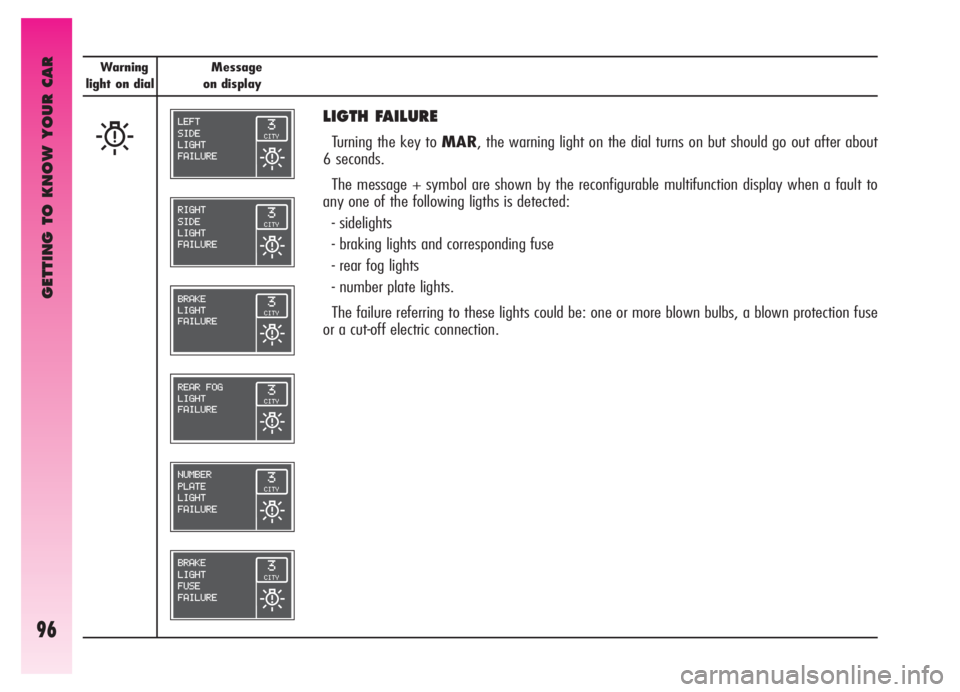
GETTING TO KNOW YOUR CAR
96
Warning
light on dialMessage
on display
W
LIGTH FAILURE
Turning the key to MAR, the warning light on the dial turns on but should go out after about
6 seconds.
The message + symbol are shown by the reconfigurable multifunction display when a fault to
any one of the following ligths is detected:
- sidelights
- braking lights and corresponding fuse
- rear fog lights
- number plate lights.
The failure referring to these lights could be: one or more blown bulbs, a blown protection fuse
or a cut-off electric connection.
Page 99 of 307

GETTING TO KNOW YOUR CAR
97
Warning
light on dialMessage
on display
SPEED LIMIT EXCEEDED
On some versions the warning light turns on, together with the message on the display and the
sounding of the buzzer, when the vehicle exceeds the speed limit set previously (see the
“Reconfigurable multifunction display” chapter).
K
FUEL RESERVE
The warning light on the dial turns on (on some versions the message + symbol are shown on
the reconfigurable multifunction display) when about 7 litres of fuel are left in the tank and on
certain versions when autonomy is below 50 km.
AUTONOMY (TRIP COMPUTER)
The message + symbol are shown on the reconfigurable multifunction display when autonomy
is below 50 km.
SCHEDULED MAINTENANCE
This is shown on the reconfigurable multifunction display 2000 km from the deadline given in
the Scheduled Maintenance Programme (every 20,000 km) and it is shown again at timed inter-
vals, turning the ignition key to MARevery 200 km.
Page 111 of 307

GETTING TO KNOW YOUR CAR
109
- temperature of the air admitted to the
passenger compartment (for the driver’s and
passenger’s side separately)
- fan speed
- air distribution
- inside air re-circulation on/off
- climate control compressor on/off en-
able.
It is possible to change the setting of the
following functions manually:
- fan speed
- air distribution
- inside air re-circulation on/off
- climate control compressor on/off en-
able.
The control of functions not changed man-
ually remains automatic and in any case the
temperature of the air admitted to the pas-
senger compartment is controlled automati-
cally according to the temperatures set on
the driver’s and passenger’s displays.
IMPORTANTManual selections prevail
over automatic ones and remain in storage
until the user decides to resume automatic
control. The settings selected manually are
stored when the engine is switched off and
resumed the next time it is started. To ensure correct opera-
tion of the incipient mist-
ing sensor, stickers must
not be applied (road licence holder,
time card etc.). Care should also be
given to cleaning the windscreen
and the actual sensor, avoiding the
accumulation of dust and other sub-
stances.IMPORTANTThe demisting procedure
is enabled each time the ignition key is
turned to MARor pressing the
AUTObut-
ton. When this procedure is working it can
be turned off pressing one of the following
buttons: compressor, air recirculation, air
flow, air capacity. This operation inhibits the
incipient misting sensor signal until the
AUTObutton is pressed again or the next
time the ignition key is turned toMAR.
On certain versions, the system is inte-
grated by an antipollution sensor capable of
automatically switching on inside air re-cir-
culation to lessen the harmful effects of pol-
luted air in cities, queues, tunnels and op-
eration of the windscreen washer (with the
typical smell of spirit).
IMPORTANTThe function of the an-
tipollution sensor is subordinate to safety
conditions; therefore disabling the climate
control compressor or at an outside tem-
perature below 4°C the sensor is disabled.
The sensor can be re-enabled pressing the
re-circulation button
vuntil taking it to
the automatic mode.
Air quality control is also entrusted to a
combined particle and activated carbon fil-
ter. The climate control system automatically
controls and adjusts the following parame-
ters and functions: On some versions the system is integrat-
ed with an incipient misting sensor installed
behind the inside rear-view mirror, capable
of “controlling” a predefined area of the
windscreen inner surface which can auto-
matically act on the system to prevent or re-
duce misting through a series of operations
such as: opening air re-circulation, enabling
the compressor, air flow to the windscreen,
fan speed sufficient for demisting; in the
case of heavy misting, enabling the
MAX-
DEFfunction.
Page 115 of 307
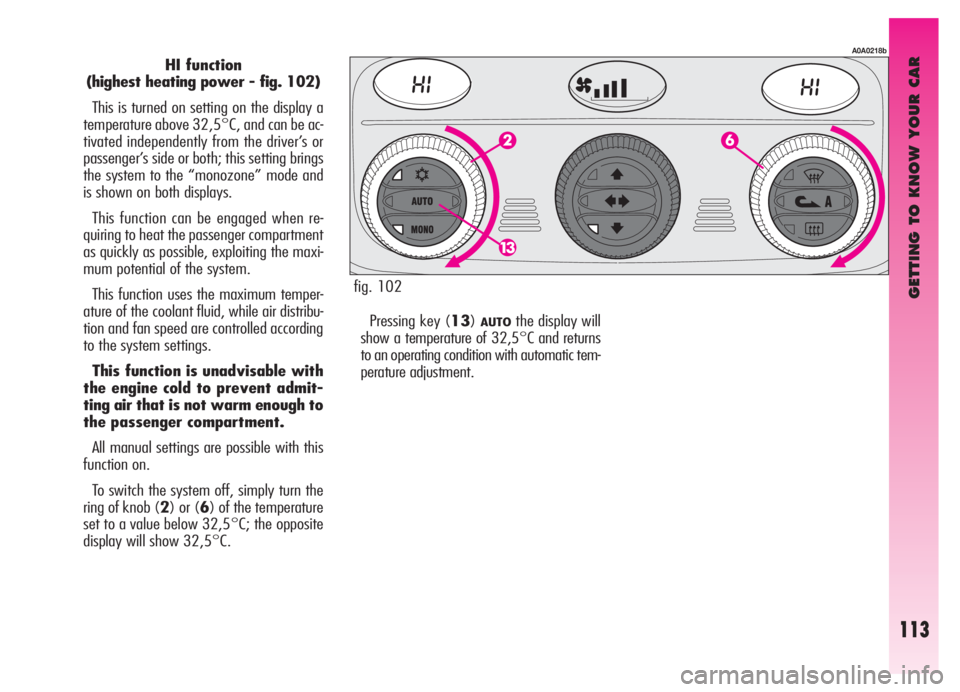
GETTING TO KNOW YOUR CAR
113
HI function
(highest heating power - fig. 102)
This is turned on setting on the display a
temperature above 32,5°C, and can be ac-
tivated independently from the driver’s or
passenger’s side or both; this setting brings
the system to the “monozone” mode and
is shown on both displays.
This function can be engaged when re-
quiring to heat the passenger compartment
as quickly as possible, exploiting the maxi-
mum potential of the system.
This function uses the maximum temper-
ature of the coolant fluid, while air distribu-
tion and fan speed are controlled according
to the system settings.
This function is unadvisable with
the engine cold to prevent admit-
ting air that is not warm enough to
the passenger compartment.
All manual settings are possible with this
function on.
To switch the system off, simply turn the
ring of knob (2) or (6) of the temperature
set to a value below 32,5°C; the opposite
display will show 32,5°C.
A0A0218b
fig. 102
Pressing key (13)
AUTOthe display will
show a temperature of 32,5°C and returns
to an operating condition with automatic tem-
perature adjustment.
Page 116 of 307

GETTING TO KNOW YOUR CAR
114
LO function
(highest cooling power - fig. 103)
This is turned on setting on the display a
temperature below 16,5°C; this setting is
shown on both displays.
This function can be engaged when re-
quiring to cool the passenger compartment
as quickly as possible, exploiting the maxi-
mum potential of the system.
The function cuts off air heating, engages
inside air re-circulation (to prevent admitting
hot air to the passenger compartment) and
the climate control compressor, takes air dis-
tribution to
REand the fan speed as set
by the system.
All manual settings are possible with this
function on.
To switch the function off, simply turn the
ring of knob (2) or (6) of the temperature
set on a value above 16,5°C; the opposite
display will show 16,5°C.
Pressing key (13)
AUTOthe display will
show a temperature of 16,5°C and returns
to an operating condition with automatic
temperature adjustment.
A0A0219b
fig. 103
Page 126 of 307
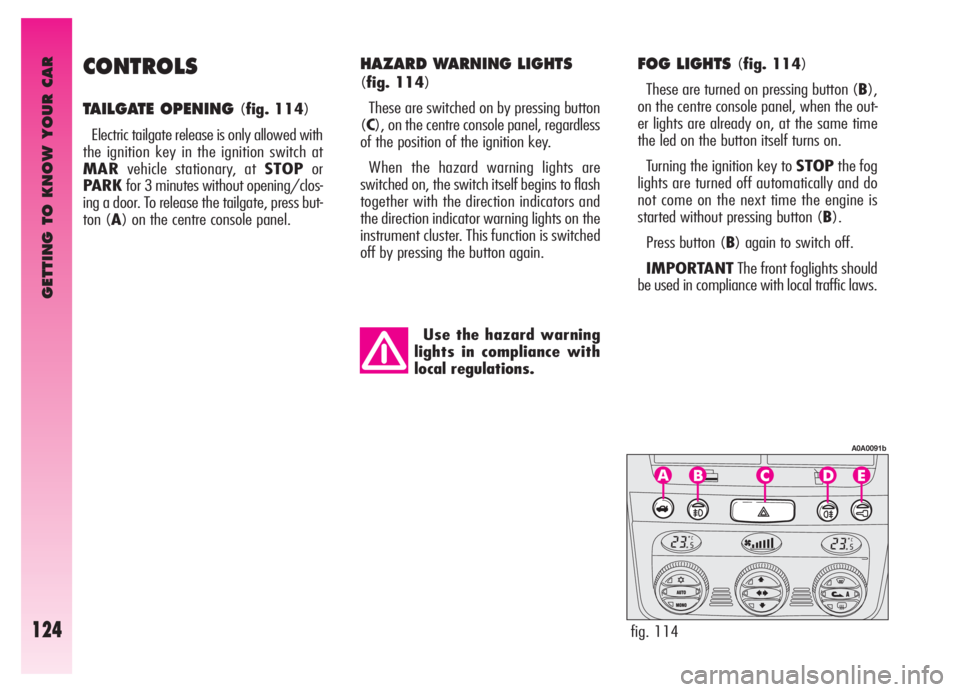
GETTING TO KNOW YOUR CAR
124
CONTROLS
TAILGATE OPENING (fig. 114)
Electric tailgate release is only allowed with
the ignition key in the ignition switch at
MARvehicle stationary, at STOPor
PARK for 3 minutes without opening/clos-
ing a door. To release the tailgate, press but-
ton (A) on the centre console panel.
Use the hazard warning
lights in compliance with
local regulations.
FOG LIGHTS (fig. 114)
These are turned on pressing button (B),
on the centre console panel, when the out-
er lights are already on, at the same time
the led on the button itself turns on.
Turning the ignition key to STOPthe fog
lights are turned off automatically and do
not come on the next time the engine is
started without pressing button (B).
Press button (B) again to switch off.
IMPORTANTThe front foglights should
be used in compliance with local traffic laws.
fig. 114
A0A0091b
HAZARD WARNING LIGHTS
(fig. 114)
These are switched on by pressing button
(C), on the centre console panel, regardless
of the position of the ignition key.
When the hazard warning lights are
switched on, the switch itself begins to flash
together with the direction indicators and
the direction indicator warning lights on the
instrument cluster. This function is switched
off by pressing the button again.
Page 127 of 307
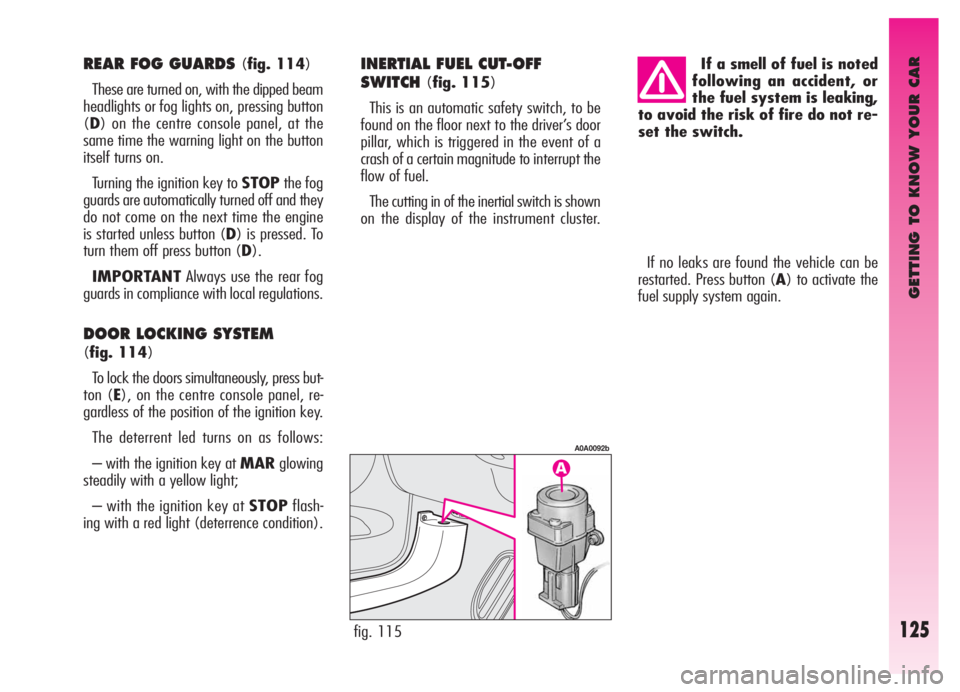
GETTING TO KNOW YOUR CAR
125
If no leaks are found the vehicle can be
restarted. Press button (A) to activate the
fuel supply system again.
fig. 115
A0A0092b
If a smell of fuel is noted
following an accident, or
the fuel system is leaking,
to avoid the risk of fire do not re-
set the switch.REAR FOG GUARDS (fig. 114)
These are turned on, with the dipped beam
headlights or fog lights on, pressing button
(D) on the centre console panel, at the
same time the warning light on the button
itself turns on.
Turning the ignition key to STOPthe fog
guards are automatically turned off and they
do not come on the next time the engine
is started unless button (D) is pressed. To
turn them off press button (D).
IMPORTANTAlways use the rear fog
guards in compliance with local regulations.
DOOR LOCKING SYSTEM
(fig. 114)
To lock the doors simultaneously, press but-
ton (E), on the centre console panel, re-
gardless of the position of the ignition key.
The deterrent led turns on as follows:
– with the ignition key at MARglowing
steadily with a yellow light;
– with the ignition key at STOPflash-
ing with a red light (deterrence condition).
INERTIAL FUEL CUT-OFF
SWITCH
(fig. 115)
This is an automatic safety switch, to be
found on the floor next to the driver’s door
pillar, which is triggered in the event of a
crash of a certain magnitude to interrupt the
flow of fuel.
The cutting in of the inertial switch is shown
on the display of the instrument cluster.
Page 128 of 307

GETTING TO KNOW YOUR CAR
126
The adjustment of Xenon headlights is au-
tomatic, therefore the versions fitted with
this optional lack the headlight aiming de-
vice (fig. 116a).
HAND BRAKE(fig. 117)
The hand brake lever is located between
the two front seats.
To operate the brake when the vehicle is
stationary, pull lever (A) upwards, until the
required braking action is obtained.
When the ignition key is at MAR, the
warning light on the instrument cluster
x
will come on.
fig. 117
A0A0620b
fig. 116a versions with Xenon headlights
A0A0677b
Adjust the beams every
time the load carried
changes.
For correct adjustment, bear in mind the
following conditions:
– position 0: one or two people occupy-
ing the the front seats
– position 1: five people;
– position 2: five people + load in the
boot;
– position 3: driver + maximum permis-
sible load all stowed in lug-
gage compartment
fig. 116 versions without Xenon headlights
A0A0093b
HEADLIGHT AIMING DEVICE
(fig. 116)
The headlights should be aimed correctly
depending on the vehicle load.
To do this, use the rocker button (A), on
the plate at the side of the steering column:
– press the arrow on the button (
A), to
increase by one position (e.g.:0
➟1➟2➟
3);
– press the arrow on the button (
S), to lower
by one position (e.g.:3
➟2➟1➟0);
The display (B) in the tachometer shows the
positions during adjustment.
Page 131 of 307
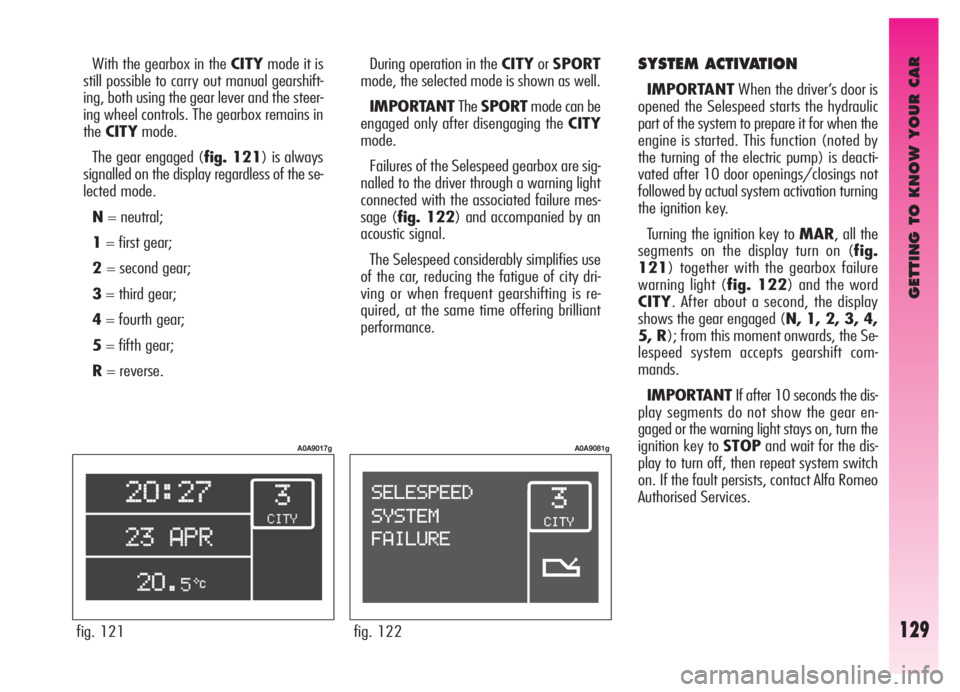
GETTING TO KNOW YOUR CAR
129
SYSTEM ACTIVATION
IMPORTANTWhen the driver’s door is
opened the Selespeed starts the hydraulic
part of the system to prepare it for when the
engine is started. This function (noted by
the turning of the electric pump) is deacti-
vated after 10 door openings/closings not
followed by actual system activation turning
the ignition key.
Turning the ignition key to MAR, all the
segments on the display turn on (fig.
121) together with the gearbox failure
warning light (fig. 122) and the word
CITY. After about a second, the display
shows the gear engaged (N, 1, 2, 3, 4,
5, R); from this moment onwards, the Se-
lespeed system accepts gearshift com-
mands.
IMPORTANTIf after 10 seconds the dis-
play segments do not show the gear en-
gaged or the warning light stays on, turn the
ignition key to STOPand wait for the dis-
play to turn off, then repeat system switch
on. If the fault persists, contact Alfa Romeo
Authorised Services. With the gearbox in the CITYmode it is
still possible to carry out manual gearshift-
ing, both using the gear lever and the steer-
ing wheel controls. The gearbox remains in
theCITYmode.
The gear engaged (fig. 121) is always
signalled on the display regardless of the se-
lected mode.
N= neutral;
1= first gear;
2= second gear;
3= third gear;
4= fourth gear;
5= fifth gear;
R= reverse.During operation in the CITYorSPORT
mode, the selected mode is shown as well.
IMPORTANTTheSPORTmode can be
engaged only after disengaging the CITY
mode.
Failures of the Selespeed gearbox are sig-
nalled to the driver through a warning light
connected with the associated failure mes-
sage (fig. 122) and accompanied by an
acoustic signal.
The Selespeed considerably simplifies use
of the car, reducing the fatigue of city dri-
ving or when frequent gearshifting is re-
quired, at the same time offering brilliant
performance.
fig. 121
A0A9017g
fig. 122
A0A9081g
Page 133 of 307
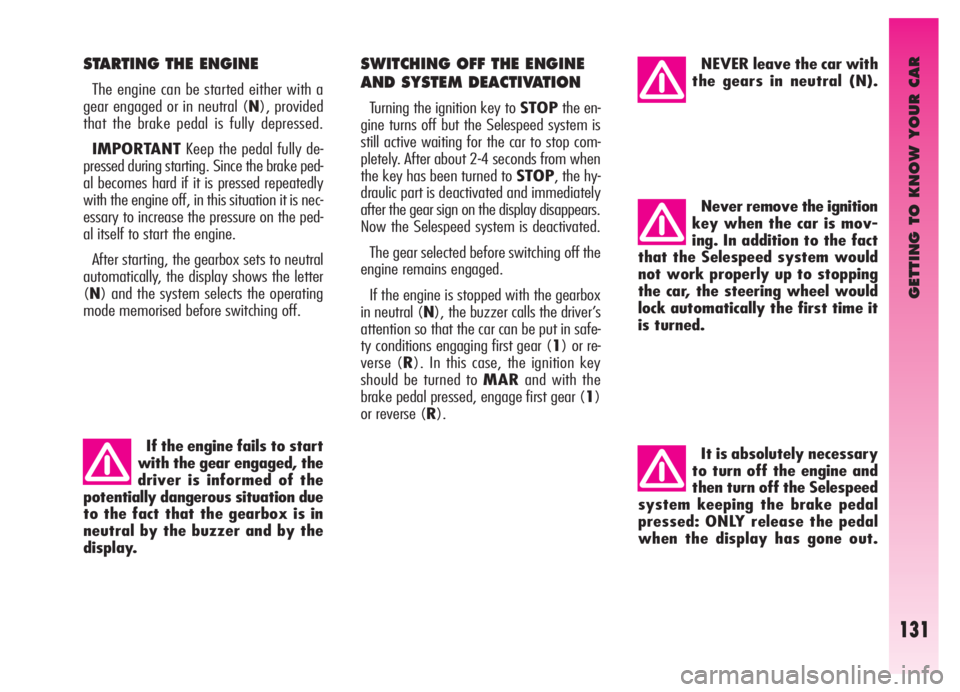
GETTING TO KNOW YOUR CAR
131
Never remove the ignition
key when the car is mov-
ing. In addition to the fact
that the Selespeed system would
not work properly up to stopping
the car, the steering wheel would
lock automatically the first time it
is turned.
STARTING THE ENGINE
The engine can be started either with a
gear engaged or in neutral (N), provided
that the brake pedal is fully depressed.
IMPORTANTKeep the pedal fully de-
pressed during starting. Since the brake ped-
al becomes hard if it is pressed repeatedly
with the engine off, in this situation it is nec-
essary to increase the pressure on the ped-
al itself to start the engine.
After starting, the gearbox sets to neutral
automatically, the display shows the letter
(N) and the system selects the operating
mode memorised before switching off.
If the engine fails to start
with the gear engaged, the
driver is informed of the
potentially dangerous situation due
to the fact that the gearbox is in
neutral by the buzzer and by the
display.
SWITCHING OFF THE ENGINE
AND SYSTEM DEACTIVATION
Turning the ignition key to STOPthe en-
gine turns off but the Selespeed system is
still active waiting for the car to stop com-
pletely. After about 2-4 seconds from when
the key has been turned to STOP, the hy-
draulic part is deactivated and immediately
after the gear sign on the display disappears.
Now the Selespeed system is deactivated.
The gear selected before switching off the
engine remains engaged.
If the engine is stopped with the gearbox
in neutral (N), the buzzer calls the driver’s
attention so that the car can be put in safe-
ty conditions engaging first gear (1) or re-
verse (R). In this case, the ignition key
should be turned to MARand with the
brake pedal pressed, engage first gear (1)
or reverse (R).
NEVER leave the car with
the gears in neutral (N).
It is absolutely necessary
to turn off the engine and
then turn off the Selespeed
system keeping the brake pedal
pressed: ONLY release the pedal
when the display has gone out.